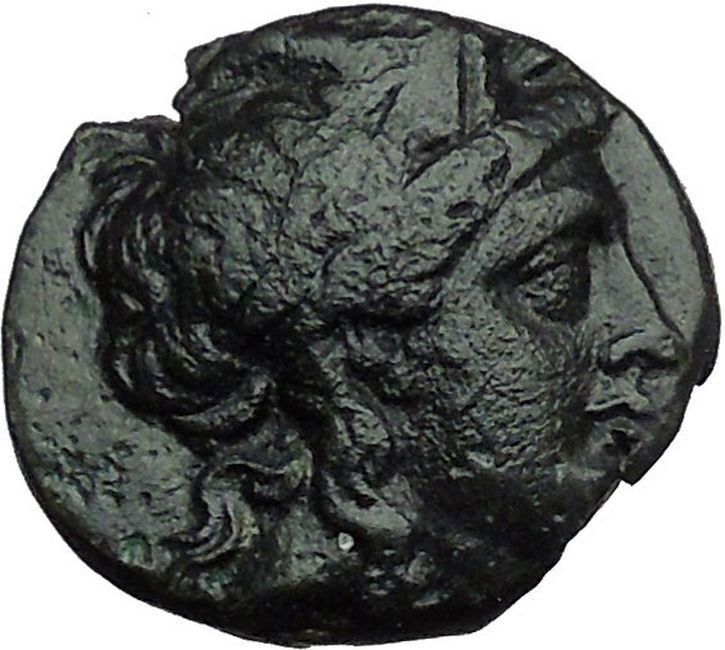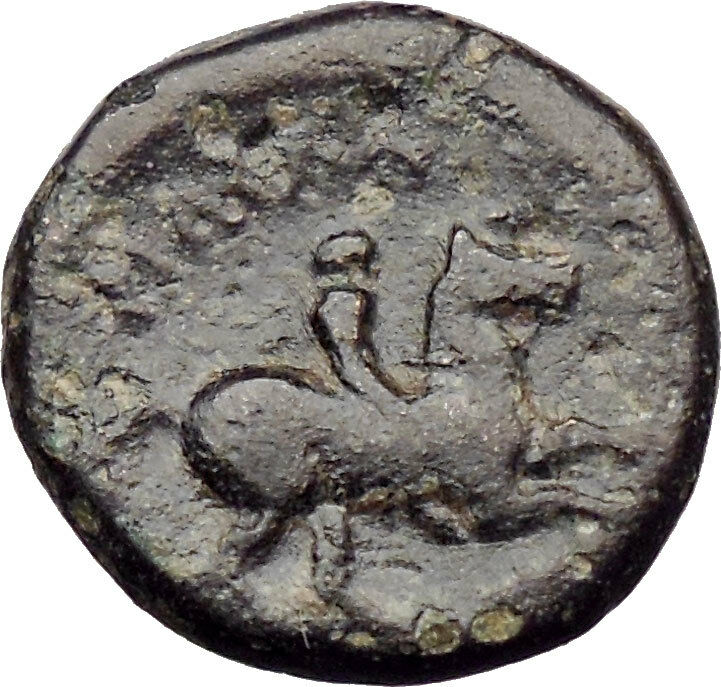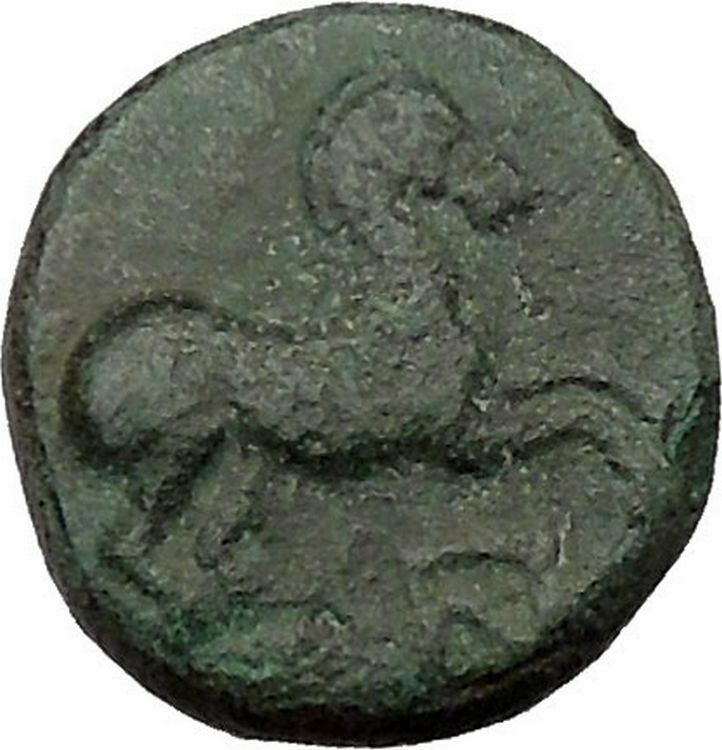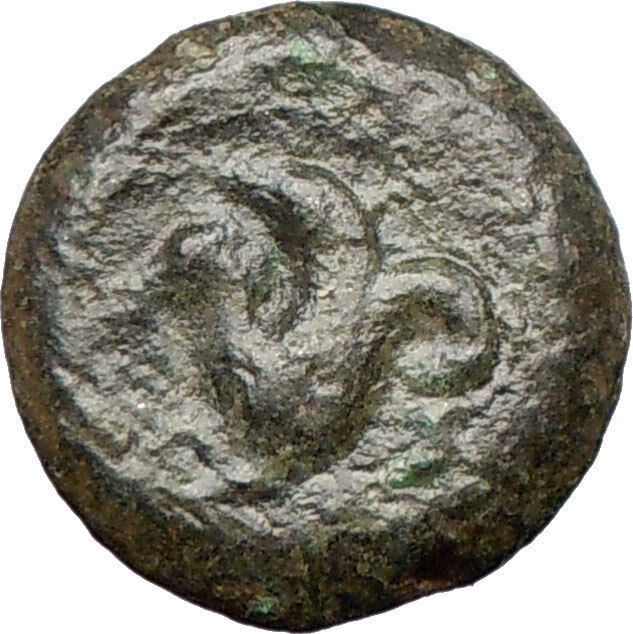|
Greek coin of the
Akarnanian League
Bronze 20mm (7.02 grams) Struck circa 250-167 B.C.
Reference:
HGC 4, 737; Sear 2313; B.M.C. 7.,p.169,16-18,20
Head of young Hercules right, wearing lion skin headdress.
Bearded head of river-god Achelous right; trident right above, A behind.
The rugged region in
north-western Greece, according to Greek mythology derived it’s name from
Akarnan, son of the Argive king Amphiarios who settled at the mouth of the
Achelous river. The myth goes that the river-god Archelous and Hercules had a
competition for the hand in marriage of Deianaira, an Aitolian princess. When
wrestling Hercules, Archelous transformed first into a serpent and then into a
man-headed bull, with the ultimate victory going to Hercules. While wrestling,
Hercules tore one of the the horns of Archelous off. The power the river-god had
was to water the land fruitful, and in correlation his horn became the
cornucopia (“full horn” or “horn of plenty”) with the amazing power to always
refill itself.
You are bidding on the exact item pictured,
provided with a Certificate of Authenticity and Lifetime Guarantee of
Authenticity.
In
Greek mythology
, Achelous was the patron
deity of the “silver-swirling”
Achelous River
, which is the largest river of
Greece, and thus the chief of all river deities, every river having its own
river spirit. His name is pre-Greek, its meaning unknown. The Greeks invented
etymologies to associate it with Greek word roots (one such popular etymology
translates the name as “he who washes away care”). However, these are
etymologically unsound and of much later origin than the name itself.

Achelous was often reduced to a bearded mask, an inspiration for the
medieval
Green Mann. Floor mosaic,
Zeugma, Turkey.
Origin
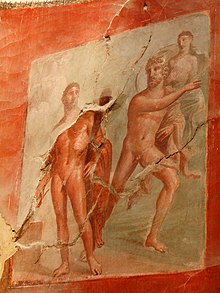
Hercules and Achelous in a Roman wall painting from the
Hall of the Augustales
Some Greek sources say that he was the son of Gaia and
Oceanus
; however, ancient Greeks generally
believed with Hesiod that
Tethys
and
Oceanus
were the parents of all three thousand
river gods. In the Renaissance, the improvisatory mythographer Natalis Comes
made for his parents
Gaia
and
Helios
,
Homer
placed Achelous above all, the origin of
all the world’s fresh water. By Roman times, Homer’s reference was interpreted
as making Achelous “prince of rivers”.
Others derived the legends about Achelous from Egypt, and describe him as a
second
Nilus
. But however this may be, he was from the
earliest times considered to be a great divinity throughout Greece, and was
invoked in prayers, sacrifices, on taking oaths, &c., and the
oracular Zeus at Dodona
usually added to each
oracle he gave, the command to offer sacrifices to Achelous. This wide extent of
the worship of Achelous also accounts for his being regarded as the
representative of sweet water in general, that is, as the source of all
nourishment.
Mythological tradition
Achelous was a suitor for
Deianeira
, daughter of
Oeneus
king of
Calydon
, but was defeated by
Heracles
, who wed her himself.
Sophocles
pictures a mortal woman’s terror at
being courted by a chthonic river god:
- ‘My suitor was the river Achelóüs,
- who took three forms to ask me of my father:
- a rambling bull once, then a writhing snake
- of gleaming colors, then again a man
- with ox-like face: and from his beard’s dark shadows
- stream upon stream of water tumbled down.
- Such was my suitor.’ (Sophocles, Trachiniae, tr. Robert Torrance)

bronze
coin struck in
Oiniadai
219-211 BC depicting
river-god
Achelous as man-faced
bull
on reverse

The rivalry of Hercules and the river-god Achelous is depicted in
this plaque by
Annibale Fontana
. The Walters Art
Museum.
The contest of Achelous with Heracles was represented on the throne of
Amyclae
, and in the treasury of the
Megarans
at
Olympia
there was a statue of him made by
Dontas
of cedarwood and gold. On several coins
of Acarnania
the god is represented as a bull with
the head of an old man.
The sacred bull
, the
serpent
and the
Minotaur
are all creatures associated with the
Earth goddess Gaia. Achelous was most often depicted as a gray-haired old man or
a vigorous bearded man in his prime, with a horned head and a serpent-like body.
When he battled Heracles over the river nymph Deianeira, Achelous turned himself
into a bull. Heracles tore off one of his horns and forced the god to surrender.
Achelous had to trade the goat horn of
Amalthea
to get it back. Heracles gave it to
the
Naiads
, who transformed it into the
cornucopia
. Achelous relates the bitter episode
afterwards to Theseus
in
Ovid‘s
Metamorphoses
.
Sophocles
makes Deianeira relate these
occurrences in a somewhat different manner.
The mouth of the Achelous river was the spot where
Alcmaeon
finally found peace from the
Erinyes
. Achelous offered him Callirhoe, his
daughter, in marriage if Alcmaeon would retrieve the clothing and jewelry his
mother Eriphyle
had been wearing when she sent her
husband Amphiaraus
to his death. Alcmaeon had to
retrieve the clothes from King
Phegeus
, who sent his sons to kill Alcmaeon.

The Banquet of Achelous (ca. 1615), by
Rubens
Ovid
in his Metamorphoses provided a
descriptive interlude when
Theseus
is the guest of Achelous, waiting for
the river’s raging flood to subside: “He entered the dark building, made of
spongy pumice, and rough tuff. The floor was moist with soft moss, and the
ceiling banded with freshwater mussel and oyster shells.” In sixteenth-century
Italy, an aspect of the revival of Antiquity was the desire to recreate
Classical spaces as extensions of the revived
villa
. Ovid’s description of the cave of
Achelous provided some specific inspiration to patrons in France as well as
Italy for the Mannerist
garden
grotto
, with its cool dampness,
tuff vaulting and shellwork walls. The banquet served by Ovid’s
Achelous offered a prototype for Italian midday feasts in the fountain-cooled
shade of garden grottoes.
At the mouth of the Achelous River lie the
Echinades
Islands. According to Ovid’s pretty
myth-making in the same Metamorphoses episode, the Echinades Islands were
once five nymphs. Unfortunately for them, they forgot to honor Achelous in their
festivities, and the god was so angry about this slight that he turned them into
the islands.
Achelous was sometimes the father of the
Sirens
by
Terpsichore
, or in a later version, they are
from the blood he shed where Heracles broke off his horn.
In another mythic context, the Achelous was said to be formed by the tears of
Niobe
, who fled to
Mount Sipylus
after the deaths of her husband
and children.
In Hellenistic and Roman contexts, the river god was often reduced to a mask
and used decoratively as an emblem of water, “his uncut hair wreathed with
reeds”. The feature survived in Romanesque carved details and flowered duruing
the Middle Ages
as one of the Classical prototypes
of the Green Man.
Achelous and
the River Achelous
The origin of the river Achelous is thus described by
Servius
:
When Achelous on one occasion had lost his daughters, the
Sirens
, and in his grief invoked his mother
Gaea, she received him to her bosom, and on the spot where she received him,
she caused the river bearing his name to gush forth.
Other accounts about the origin of the river and its name are given by
Stephanus of Byzantium
,
Strabo
, and
Plutarch
.
Strabo
proposes a very ingenious interpretation
of the legends about Achelous, all of which according to him arose from the
nature of the river itself. It resembled a bull’s voice in the noise of the
water; its windings and its reaches gave rise to the story about his forming
himself into a serpent and about his horns; the formation of islands at the
mouth of the river requires no explanation. His conquest by Heracles lastly
refers to the embankments by which Heracles confined the river to its bed and
thus gained large tracts of land for cultivation, which are expressed by the
horn of plenty.
Hercules is the Roman name for the Greek
divine
hero Heracles
, who was the son of
Zeus (Roman equivalent
Jupiter
) and the mortal
Alcmene
. In
classical mythology
, Hercules is famous for his
strength and for his numerous far-ranging adventures.

The
Romans adapted the Greek hero’s iconography and myths for their literature and
art under the name Hercules. In later
Western art
and literature and in
popular culture
, Hercules is more
commonly used than Heracles as the name of the hero. Hercules was a
multifaceted figure with contradictory characteristics, which enabled later
artists and writers to pick and choose how to represent him. This article
provides an introduction to representations of Hercules in the
later tradition
.
Labors of Hercules
Hercules is known for his many adventures, which took him to the far reaches
of the
Greco-Roman world
. One cycle of these
adventures became
canonical
as the “Twelve Labours,” but the list
has variations. One traditional order of the labours is found in the
Bibliotheca
as follows:
- Slay the
Nemean Lion
.
- Slay the nine-headed
Lernaean Hydra
.
- Capture the
Golden Hind of Artemis
.
- Capture the
Erymanthian Boar
.
- Clean the Augean
stables in a single day.
- Slay the
Stymphalian Birds
.
- Capture the
Cretan Bull
.
- Steal the
Mares of Diomedes
.
- Obtain the girdle of
Hippolyta
, Queen of the
Amazons
.
- Obtain the cattle of the monster
Geryon
.
- Steal the apples of the
Hesperides
.
- Capture and bring back
Cerberus
.
The Latin
name Hercules was borrowed through
Etruscan
, where it is represented variously as
Heracle
, Hercle, and other forms. Hercules was
a favorite subject for
Etruscan art
, and appears often on
bronze mirrors
. The Etruscan form Herceler
derives from the Greek Heracles via
syncope
. A mild oath invoking Hercules (Hercule!
or Mehercle!) was a common
interjection
in
Classical Latin
.

Baby Hercules strangling a
snake
sent to
kill him in his
cradle
(Roman marble, 2nd century CE)
Hercules had a number of
myths
that were distinctly Roman. One of these
is Hercules’ defeat of
Cacus
, who was terrorizing the countryside of
Rome. The hero was associated with the
Aventine Hill
through his son
Aventinus
.
Mark Antony
considered him a personal patron
god, as did the emperor
Commodus
. Hercules received various forms of
religious veneration
, including as a
deity concerned with children and childbirth
,
in part because of myths about his precocious infancy, and in part because he
fathered countless children. Roman brides wore a special belt tied with the “knot
of Hercules“, which was supposed to be hard to untie. The comic
playwright Plautus
presents the myth of Hercules’
conception as a sex comedy in his play
Amphitryon
;
Seneca
wrote the tragedy Hercules Furens
about his bout with madness. During the
Roman Imperial era
, Hercules was worshipped
locally from Hispania
through
Gaul.
Medieval mythography
After the Roman Empire became
Christianized
, mythological narratives were
often reinterpreted as
allegory
, influenced by the philosophy of
late antiquity
. In the 4th century,
Servius
had described Hercules’ return from the
underworld as representing his ability to overcome earthly desires and vices, or
the earth itself as a consumer of bodies. In medieval mythography, Hercules was
one of the heroes seen as a strong role model who demonstrated both valor and
wisdom, with the monsters he battles as moral obstacles. One
glossatorr
noted that when
Hercules became a constellation
, he showed that
strength was necessary to gain entrance to Heaven.
Renaissance
mythography
The Renaissance
and the invention of the
printing press
brought a renewed interest in
and publication of Greek literature. Renaissance mythography drew more
extensively on the Greek tradition of Heracles, typically under the Romanized
name Hercules, or the alternate name
Alcides
. In a chapter of his book
Mythologiae (1567), the influential mythographer
Natale Conti
collected and summarized an
extensive range of myths concerning the birth, adventures, and death of the hero
under his Roman name Hercules. Conti begins his lengthy chapter on Hercules with
an overview description that continues the moralizing impulse of the Middle
Ages::
Acarnania is a region of west-central
Greece
that lies along the
Ionian Sea
, west of
Aetolia
, with the
Achelous River
for a boundary, and north of the
gulf of Calydon
, which is the entrance to the
Gulf of Corinth
. Today it forms the western
part of the
regional unit
of
Aetolia-Acarnania
. The capital and principal
city in ancient times was
Stratos
. The north side of Acarnania of the
Corinthian Gulf
was considered part of the
region of Epirus
.
Acarnania’s foundation in
Greek mythology
was traditionally ascribed to
Acarnan
, son of
Alcmaeon
.
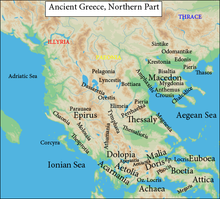
Ancient Greek Northern regions
History
Classical
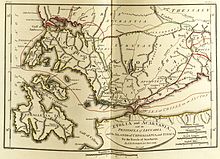
Map of ancient Acarnania.
In the 7th century BC,[2]
Greek influence in the region becomes prominent when
Corinth
settled Anactorium, Sollium and
Leucas
, and
Kefalonia
settled Astacus. Settlements in
Alyzeia, Coronta, Limnaea, Medion,
Oeniadae
, Palaerus, Phytia and
Stratus
are also mentioned by
Thucydides
, this latter city being the seat of
a loose confederation of Acarnanian powers that was maintained until the late
1st century BC.
Because it is located strategically on the maritime route to Italy, Acarnania
was emmired in many wars. In 5th century BC, the
Corinthians
were forced out of their Acarnanian
settlements by Athens
. In 4th century BC, c. 390 BC, the
cities of Acarnania surrendered to the
Spartans
under
King Agesilaus
, and continued to be Spartan
allies until joining the
Second Athenian Empire
in 375 BC. The
Acarnanians later sided with
Boeotia
in their fight against Sparta, and with
Athens against
Philip II of Macedon
at
Chaeronea
.
Acarnania thereafter came under Macedonian rule. In 314 BC, at the behest of
Macedonian king
Cassander
, the settlements of Acarnania lying
near the Aetolian
border were conglomerated into fewer,
larger settlements. Still, border conflicts with the Aetolians were frequent,
and led to Acarnania’s territory being partitioned between Aetolia and
Epirus
, c. 250 BC. After the fall of the king
of Epirus, the Acarnanian territory that had been given to Epirus regained its
independence, and gained
Leucas
from Epirus, which became the capital of
the region.
Acarnania allied itself with
Philip V of Macedon
against Rome in 200 BC,
although it lost Leucas
because of this, and the city of
Thyrreion
was anointed the new capital.
In the 1st century BC, Acarnania suffered greatly at the hands of
pirates
, and in
Rome’s civil wars
. Afterwards, the towns and
settlements of Acarnania fell under the rule of
Nicopolis
.
Byzantine
Main article:
Nicopolis (theme)
When the
Byzantine Empire
broke up (1204), Acarnania
passed to the
Despotate of Epirus
and in 1348 it was
conquered by Serbia. Then in 1480 it fell to the
Ottoman Empire
. Since 1832 it has been part of
Greece.
Modern
Main article:
Aetolia-Acarnania
Geography
Acarnania is composed of three main regions: 1) a rocky coastline, 2) a
rugged strip of mountain range that follows the coastline, and 3) plains lying
between these mountains and the
Achelous River
.
|














